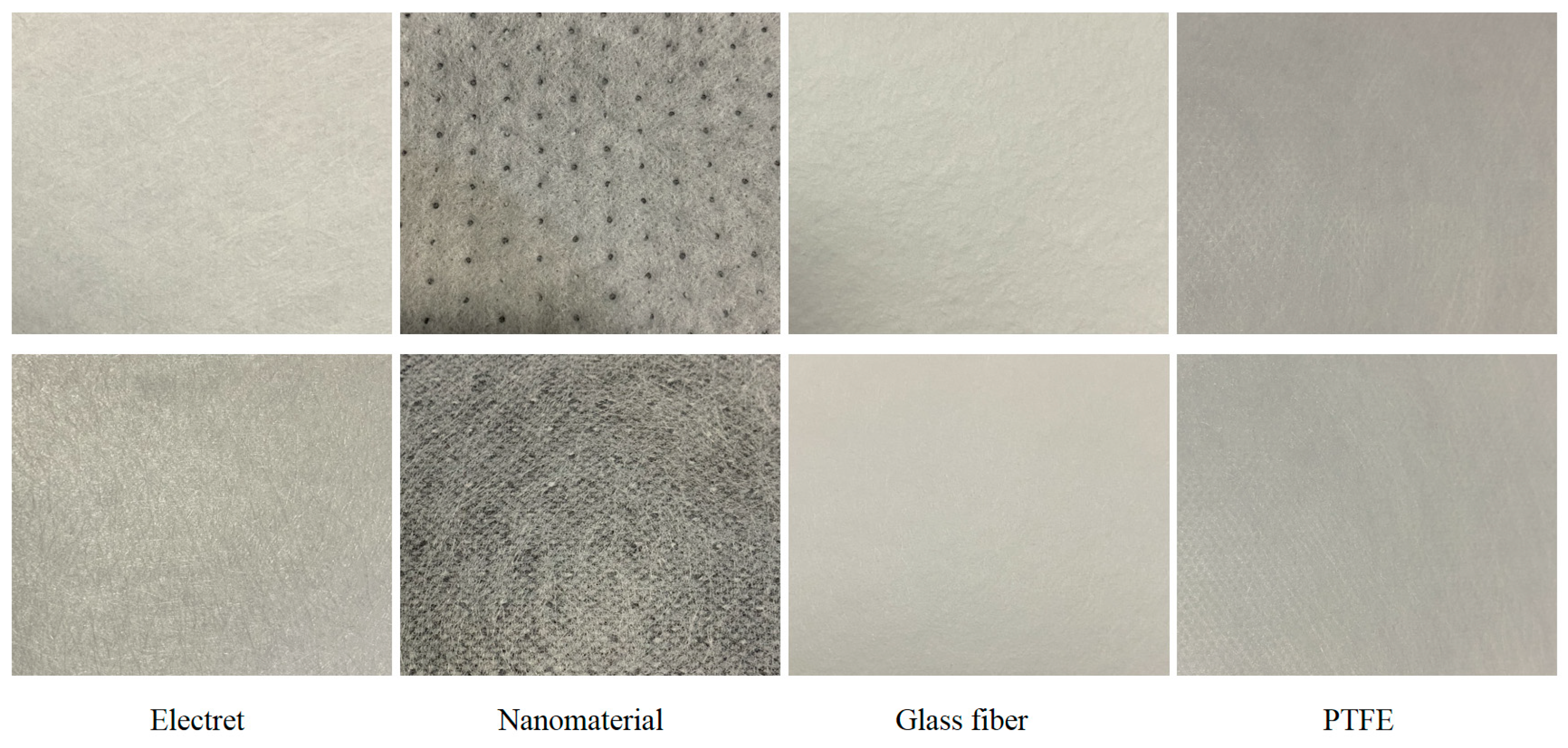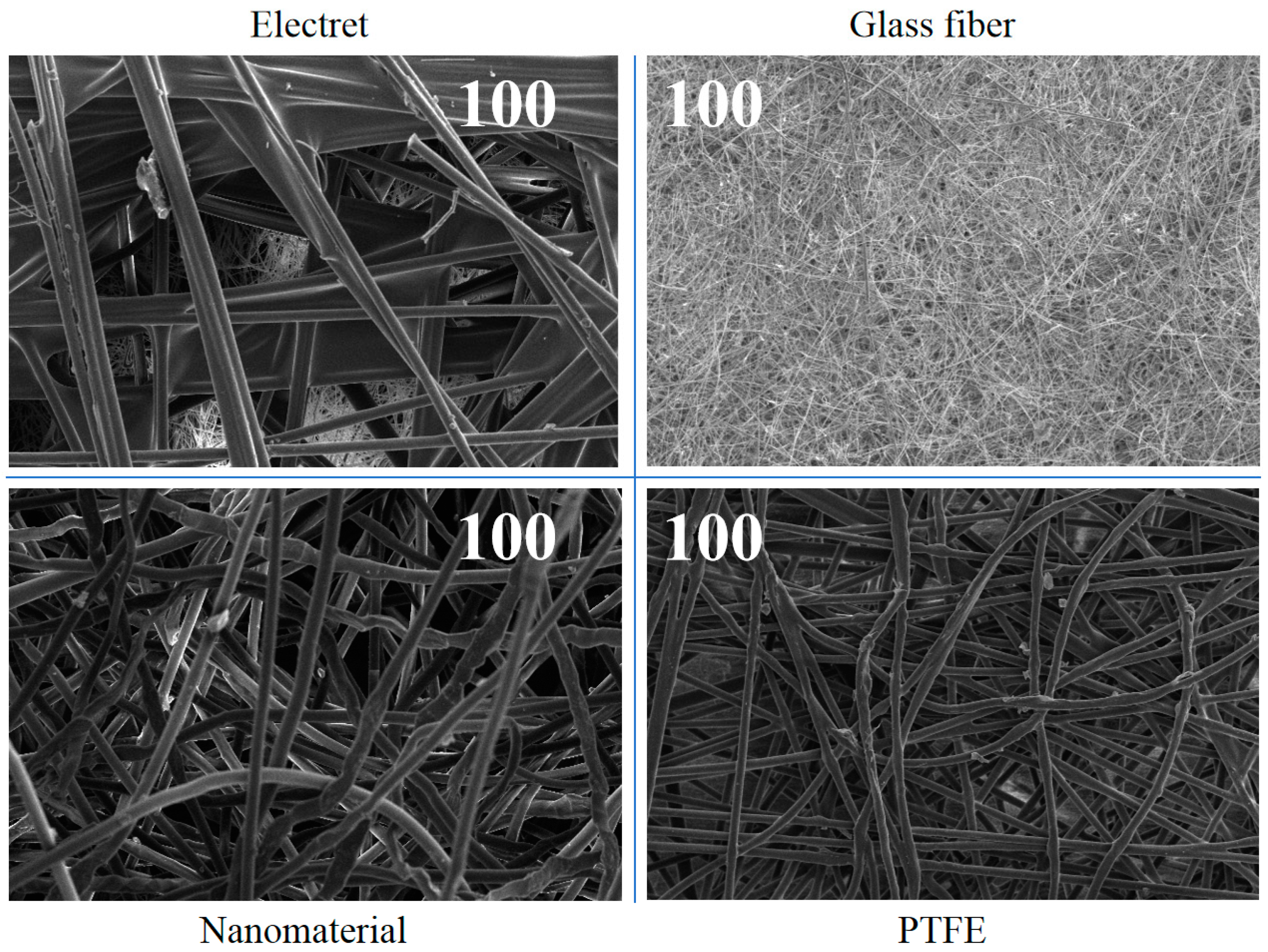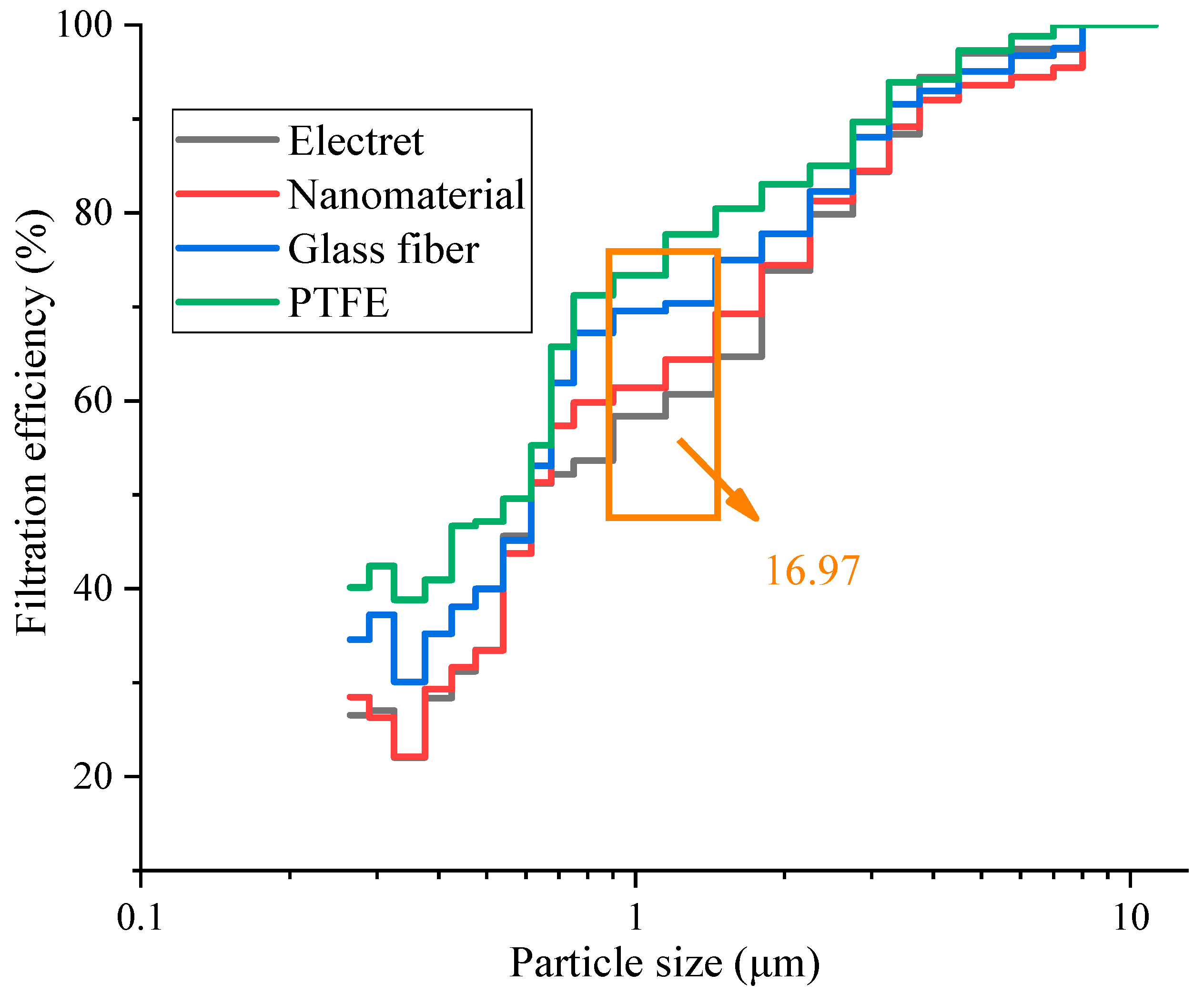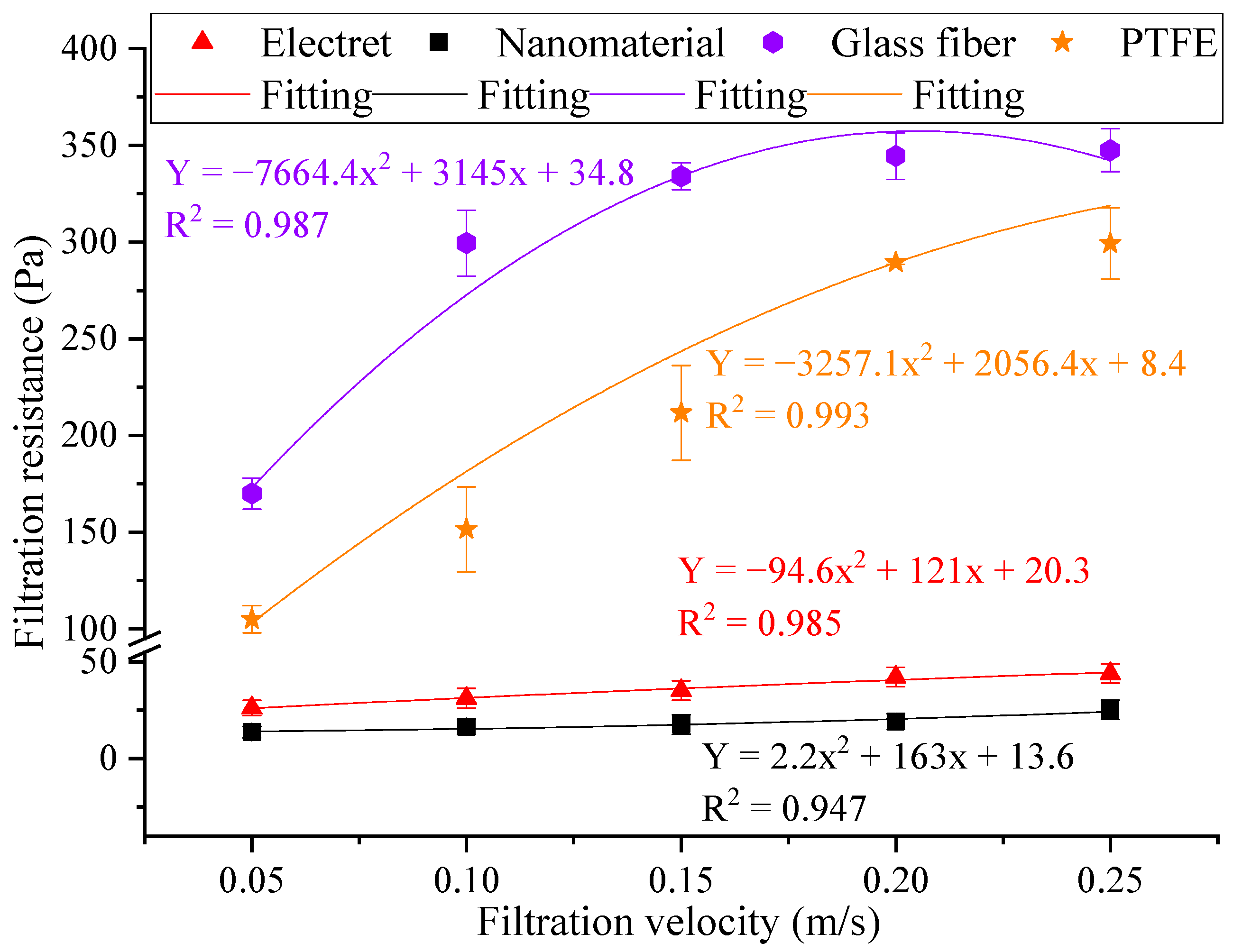The Performance Testing and Analysis of Common New Filter Materials: A Case of Four Filter Materials
Abstract
:1. Introduction
2. Materials and Methods
2.1. Parameters
2.2. Experimental Systems
2.3. Experimental Materials
3. Results and Discussion
3.1. Distribution of Atmospheric Particles
3.2. The Microstructure of Filter Materials
3.3. Influence of Filtration Velocity
3.4. Differences in Counting Filtration Efficiency for Different Particle Sizes
3.5. Changes in Filtration Resistance with Filtration Velocity
4. Conclusions
- The particle size distribution of atmospheric matter in Xi’an was mainly dominated by fine particles. Particles smaller than 2.5 μm accounted for 99.97%, while particles smaller than 1.0 μm accounted for the vast majority (~99.84%), of which particles smaller than 0.5 μm accounted for approximately 69.86%.
- The four different new filter materials showed a trend of first increasing and then decreasing their filtration efficiency with an increase in the filtration velocity. The filtration efficiency of the materials was as follows: PTFE > glass fiber > nanomaterial > electret. The filtration efficiency of all materials reached its maximum when the filtration velocity was 0.2 m/s. The filtration efficiency of the PTFE material for PM10, PM2.5, and PM1.0 was higher than that of the other three materials, with ranges of 0.87% to 24.93%, 1.21% to 18.69%, and 0.56% to 16.03%, respectively. This was because the PTFE materials had a lower porosity, which had a significant impact on the filtration performance of the filter material.
- Within the tested particle size range, the effect of the PTFE material was from 0.33% to 16.97% higher than that of the electret material, from 2.20% to 16.12% higher than that of the nanomaterial, and from 1.22% to 8.74% higher than that of the glass fiber material. PTFE was the most effective material for capturing particles smaller than 1.0 μm.
- Within the tested filtration velocity range, the resistance of the filter material showed the following trend: glass fiber > PTFE > electret > nanomaterial, and the resistance of the four materials showed a good fitting effect. It is also necessary to match the resistance with the filtration efficiency during use.
Author Contributions
Funding
Institutional Review Board Statement
Informed Consent Statement
Data Availability Statement
Conflicts of Interest
References
- Deng, Q.S.; Cuesta, L.; Alvarado, R.; Murshed, M.; Tillaguango, B.; Işık, C.; Rehman, A. Nexus between government stability and environmental pollution. J. Clean. Prod. 2024, 434, 140061. [Google Scholar] [CrossRef]
- Yang, J.; Wang, Y.Z.; Tang, C.; Zhang, Z.H. Can digitalization reduce industrial pollution? Roles of environmental investment and green innovation. Environ. Res. 2024, 240, 117442. [Google Scholar] [CrossRef]
- Jeon, J.; Chen, Y.; Kim, H. Influences of meteorology on emission sources and physicochemical properties of particulate matter in Seoul, Korea during the heating period. Atmos. Environ. 2023, 303, 119733. [Google Scholar] [CrossRef]
- Bagheri, G.; Schlenczek, O.; Turco, L.; Thiede, B.; Stieger, K.; Kosub, J.M.; Clauberg, S.; Pöhlker, M.L.; Pöhlker, C.; Moláček, J.; et al. Size, concentration, and origin of human exhaled particles and their dependence on human factors with implications on infection transmission. J. Aerosol Sci. 2023, 168, 106102. [Google Scholar] [CrossRef]
- Li, Y.F.; Frandsen, K.M.; Guo, W.Q.; Lu, Y.R.; Hvelplund, M.H.; Suolang, B.; Xi, Z.; Duan, M.J.; Liu, L. Impact of altitude on the dosage of indoor particulates entering an individual’s small airways. J. Hazard. Mater. 2024, 468, 133856. [Google Scholar] [CrossRef]
- Asbach, C.; Todea, A.M.; Kaminski, H. Evaluation of a Partector Pro for atmospheric particle number size distribution and number concentration measurements at an urban background site. Aerosol Res. 2024, 2, 1–12. [Google Scholar] [CrossRef]
- Wang, X.R.; Meng, X.; Chang, L.; Pei, F.; Wan, T.C.; Cui, T.; Liu, Y.Q.; Pan, S. Concentration, composition and exposure risk assessment of particulate matter with different particle sizes in subway stations. Build. Environ. 2024, 258, 111604. [Google Scholar] [CrossRef]
- Zou, C.W.; Liao, X.P.; Huang, H.; Tang, Y.; Li, Z.J.; Li, J.L.; Yu, C.L.; Zhu, F.X. Particle size, carbon composition and sources of indoor dust in Nanchang, China. Atmos. Pollut. Res. 2024, 15, 102052. [Google Scholar] [CrossRef]
- Zhang, X.; Ma, J.Y.; Wang, J.H.; Shi, H.X.; Guo, J.P.; Fan, Y.S.; Nie, X.X.; Guo, T.; Luo, X.X. Modifying the Fiber Structure and Filtration Performance of Polyester Materials Based on Two Different Preparation Methods. Langmuir 2023, 39, 3502–3511. [Google Scholar] [CrossRef]
- Rafryanto, A.F.; Ramadina, Z.D.P.; Nur’aini, S.; Arrosyid, B.H.; Zulfi, A.; Rochman, N.T.; Noviyanto, A.; Arramel. High Recovery of Ceramic Membrane Cleaning Remediation by Ozone Nanobubble Technology. ACS Omega 2024, 9, 11484–11493. [Google Scholar] [CrossRef]
- Jin, J.M.; Sun, M.; Yang, J.P.; Huang, Y.P.; Liu, Y.B. Janus photoelectrocatalytic filter for sustainable water decontamination. Appl. Catal. B-Environ. Energy 2023, 339, 123150. [Google Scholar]
- Tian, Y.L.; Li, X.Y.; Sun, H.T.; Xue, W.H.; Song, J.X. Characteristics of atmospheric pollution and the impacts of environmental management over a megacity, northwestern China. Urban Clim. 2022, 42, 101114. [Google Scholar] [CrossRef]
- Kahrizsangi, H.S.; Sofia, D.; Barletta, D.; Poletto, M. Dust generation in vibrated cohesive powders. Chem. Eng. Trans. 2015, 43, 769–774. [Google Scholar]
- Dziubak, T.; Dziubak, S.D. Experimental study of filtration materials used in the car air intake. Materials 2020, 13, 3498. [Google Scholar] [CrossRef]
- Zacharias, N.; Haag, A.; Lamprecht, R.B.; Gebel, J.; Essert, S.M.; Kistemann, T.; Exner, M.; Mutters, N.T.; Engelhart, S. Air filtration as a tool for the reduction of viral aerosols. Sci. Total Environ. 2021, 772, 144956. [Google Scholar] [CrossRef]
- Ahmed, U.; Hussain, T.; Abid, S. Role of knitted techniques in recent developments of biomedical applications: A review. J. Eng. Fiber Fabr. 2023, 18, 15589250231180293. [Google Scholar] [CrossRef]
- Yeganeh, F.; Chiewchan, N.; Chonkaew, W. Cellulose nanofiber/polyimide composites for highly-efficient air filters. Cellulose 2023, 58, 4421–4436. [Google Scholar] [CrossRef]
- Berry, G.; Beckman, I.; Cho, H. A comprehensive review of particle loading models of fibrous air filters. J. Aerosol Sci. 2023, 167, 106078. [Google Scholar] [CrossRef]
- Zeng, Y.X.; Liu, Q.; Zhang, X.; Wang, Z.; Yu, T.; Ren, F.; He, P.C. Comparative Filtration Performance of Composite Air Filter Materials Synthesized Using Different Impregnated Porous Media. Materials 2023, 16, 4851. [Google Scholar] [CrossRef]
- Chen, Y.; Xie, C.; Yang, S.; He, R.; Guo, Y.; Guo, Z.X.; Guo, B.H.; Tuo, X.L. Aramid-based electric heating films by incorporating carbon black. Mater. Today Commun. 2023, 34, 105105. [Google Scholar] [CrossRef]
- Wang, M.L.; Yu, D.G.; Bligh, S.W.A. Progress in preparing electrospun Janus fibers and their applications. Appl. Mater. Today 2023, 31, 101766. [Google Scholar] [CrossRef]
- Lavoie, J.; Rojas, O.J.; Khan, S.A.; Shim, E. Charge Protection in Electret Air Filtration Nonwoven Materials. Adv. Mater. Technol. 2024, 2301670. [Google Scholar] [CrossRef]
- Cigeroglu, Z.; El Messaoudi, N.; Şenol, Z.M.; Baskan, G.; Georgin, J.; Gubernat, S. Clay-based nanomaterials and their adsorptive removal efficiency for dyes and antibiotics: A review. Mater. Today Sustain. 2024, 26, 100735. [Google Scholar] [CrossRef]
- Weiter, L.; Leyer, S.; Duchowski, J.K. Enhancement of Filtration Performance Characteristics of Glass Fiber-Based Filter Media, Part 1: Mechanical Modification with Electrospun Nanofibers. Materials 2024, 17, 2209. [Google Scholar] [CrossRef]
- Qasim, S.S.B.; Al-Asfour, A.A.; Abuzayeda, M.; Mohamed, A.M.; Trajkovski, B.; Murray, C.A.; Zafiropoulos, G.G. Differences in Mechanical and Physicochemical Properties of Several PTFE Membranes Used in Guided Bone Regeneration. Materials 2023, 16, 904. [Google Scholar] [CrossRef]
- Cai, R.R.; Zhang, L.Z. Progress and perspective of polymer electret-based PM2.5 filtration: Efficiencies, regeneration, and energy implications. Energy 2023, 283, 128504. [Google Scholar] [CrossRef]
- Gao, Y.; Shi, H.X.; Zhang, X.; Ma, J.Y.; Yu, T. Differences in Performance and Conductivity Persistence of New Reduced Graphene Oxide Air Filter Materials before and after Eliminating Static Electricity. Materials 2023, 16, 7146. [Google Scholar] [CrossRef]
- Cui, Y.; Fan, Y.S.; Zhang, X.; Wang, H.; Xue, K.X.; Li, M.; Gan, W.K. Analysis and Comparative Experiment of New Reduced Graphene Oxide Filter and Electret Materials. Environ. Eng. 2022, 11, 7. (In Chinese) [Google Scholar]
- Gautam, S.; Kumar, A.; Tafreshi, H.V.; Pourdeyhimi, B. Designing Multi-Layer electret filters via numerical simulation. Chem. Eng. Sci. 2024, 286, 119680. [Google Scholar] [CrossRef]
- Kang, J.; Ko, Y.; Kim, J.P.; Kim, J.Y.; Kim, J.; Kwon, O.; Kim, K.C.; Kim, D.W. Microwave-assisted design of nanoporous graphene membrane for ultrafast and switchable organic solvent nanofiltration. Nat. Commun. 2023, 14, 901. [Google Scholar] [CrossRef]
- Correa, M.A.; Franco, S.A.; Gómez, L.M.; Aguiar, D.; Colorado, H.A. Characterization methods of ions and metals in particulate matter pollutants on PM2.5 and PM10 samples from several emission sources. Sustainability 2023, 15, 4402. [Google Scholar] [CrossRef]
- Kim, H.B.; Han, B.; Lee, M.H. Enhanced filtration characteristics of a PTFE foam-coated filter using PTFE nanofibers. Mater. Chem. Phys. 2023, 305, 127970. [Google Scholar] [CrossRef]
- Penconek, A.; Werner, Ł.; Moskal, A. Combining Solution-Blowing and Melt-Blowing Techniques to Produce an Efficient Non-Woven Filter. Processes 2024, 12, 857. [Google Scholar] [CrossRef]
- Okubo, M.; Onji, T.; Kuroki, T.; Nakano, H.; Yao, E.; Tahara, M. Molecular-level reinforced adhesion between rubber and PTFE film treated by atmospheric plasma polymerization. Plasma Chem. Plasma Process. 2016, 36, 1431–1448. [Google Scholar] [CrossRef]
- Jones, E.R.; Laurent, J.G.C.; Young, A.S.; MacNaughton, P.; Coull, B.A.; Spengler, J.D.; Allen, J.G. The effects of ventilation and filtration on indoor PM2.5 in office buildings in four countries. Build. Environ. 2021, 200, 107975. [Google Scholar] [CrossRef]
- Deng, Y.K.; Zhu, M.M.; Lu, T.; Fan, Q.W.; Ma, W.J.; Zhang, X.L.; Chen, L.; Min, H.H.; Xiong, R.H.; Huang, C.B. Hierarchical fiber with granular-convex structure for highly efficient PM2.5 capture. Sep. Purif. Technol. 2023, 304, 122235. [Google Scholar] [CrossRef]
- Chen, P. Filtration Characteristics and Application Research of Non-Woven Fiber Cabin Air Conditioning Filters. Master’s Thesis, University of South China, Hengyang, China, 2019. (In Chinese). [Google Scholar]
- Song, H.; Dong, Y.H.; Yang, J.Y.; Zhang, X.; Nie, X.X.; Fan, Y.X. Concentration Characteristics and Correlations with Other Pollutants of Atmospheric Particulate Matter as Affected by Relevant Policies. Int. J. Environ. Res. Public Health 2023, 20, 1051. [Google Scholar] [CrossRef]
- Norbu, N.; Sheng, X.L.; Liu, Q.; Han, H.H.; Zhang, X. Effect of Heating Emissions on the Fractal Size Distribution of Atmospheric Particle Concentrations. Atmosphere 2024, 15, 95. [Google Scholar] [CrossRef]
- Nawaz, S.M.; Chatterjee, M.; Chakrabarti, S.; Sepay, N.; Mallik, A. Realization of a highly-performing triboelectric nanogenerator utilizing molecular self-assembly. Nano Energy 2023, 117, 108924. [Google Scholar] [CrossRef]
- Jiang, X.; Lu, D.; Yin, B.B.; Leng, Z. Advancing carbon nanomaterials-engineered self-sensing cement composites for structural health monitoring: A state-of-the-art review. J. Build. Eng. 2024, 87, 109129. [Google Scholar] [CrossRef]
- Xu, Q.F.; Wang, G.B.; Xiang, C.H.; Cong, X.; Gai, X.Z.; Zhang, S.L.; Zhang, M.; Zhang, H.B.; Luan, J.S. Preparation of a novel poly (ether ether ketone) nonwoven filter and its application in harsh conditions for dust removal. Sep. Purif. Technol. 2020, 253, 117555. [Google Scholar] [CrossRef]
- Bian, Y.; Niu, Z.L.; Wang, S.J.; Pan, Y.; Zhang, L.; Chen, C. Removal of Size-Dependent Submicron Particles Using Metal−Organic Framework-Based Nanofiber Air Filters. ACS Appl. Mater. Interfaces 2022, 14, 23570–23576. [Google Scholar] [CrossRef]
- Yu, Z.C.; Fan, T.T.; Liu, Y.; Li, L.; Liu, J.H.; Yang, B.W.; Ramakrishna, S.; Long, Y.Z. Efficient air filtration through advanced electrospinning techniques in nanofibrous Materials: A review. Sep. Purif. Technol. 2024, 349, 127773. [Google Scholar] [CrossRef]
- Zhu, J.X.; Zhu, R.J.; Hu, Y.W.; Wang, Z.M. Low-cost and temperature-resistant mullite fiber sponges with superior thermal insulation and high-temperature PM filtration. Sep. Purif. Technol. 2023, 305, 122445. [Google Scholar] [CrossRef]
- Dziubak, T. Experimental Studies of PowerCore Filters and Pleated Filter Baffles. Materials 2022, 15, 7292. [Google Scholar] [CrossRef]
- Chen, C.W.; Huang, S.H.; Chiang, C.M.; Hsiao, T.C.; Chen, C.C. Filter quality of pleated filter cartridges. Ann. Occup. Hyg. 2008, 52, 207–212. [Google Scholar]
- Hu, X.; Zheng, W.Y.; Wu, M.C.; Chen, L.Y.; Chen, S.W. Composites of metal-organic frameworks (MOFs) and LDHs for energy storage and environmental applications: Fundamentals, progress, and perspectives. Sustain. Mater. Technol. 2023, 37, e00691. [Google Scholar] [CrossRef]







| Material | Length × Width × Thickness (mm) | Gram Weight (g/m2) | Filling Rate (%) | Porosity (%) |
|---|---|---|---|---|
| Electret | 7 × 7 × 0.23 | 177.55 | 3.52 ± 0.03 | 96.48 ± 0.03 |
| Nanomaterial | 7 × 7 × 1.22 | 342.86 | 2.49 ± 0.02 | 97.51 ± 0.02 |
| Glass fiber | 7 × 7 × 2.65 | 442.86 | 2.07 ± 0.03 | 97.93 ± 0.03 |
| PTFE | 7 × 7 × 0.14 | 169.39 | 1.65 ± 0.03 | 98.35 ± 0.03 |
| Content | Particulate Matter | Filtration Velocity (m/s) | ||||
|---|---|---|---|---|---|---|
| 0.05 | 0.1 | 0.15 | 0.2 | 0.25 | ||
| Electret | PM10 | 27.55 | 39.90 | 41.83 | 52.26 | 50.38 |
| PM2.5 | 24.01 | 37.16 | 37.69 | 44.35 | 41.31 | |
| PM1.0 | 22.48 | 35.28 | 36.56 | 42.69 | 38.06 | |
| Glass fiber | PM10 | 28.57 | 43.51 | 47.70 | 54.52 | 52.46 |
| PM2.5 | 28.32 | 38.17 | 39.07 | 46.17 | 43.70 | |
| PM1.0 | 26.18 | 34.52 | 37.53 | 43.02 | 40.04 | |
| Nanomaterial | PM10 | 43.95 | 56.62 | 65.11 | 69.30 | 66.36 |
| PM2.5 | 34.92 | 41.98 | 53.09 | 58.56 | 54.17 | |
| PM1.0 | 23.97 | 34.51 | 46.00 | 49.51 | 47.40 | |
| PTFE | PM10 | 41.25 | 59.25 | 66.77 | 71.10 | 67.23 |
| PM2.5 | 31.61 | 43.19 | 56.39 | 61.43 | 58.19 | |
| PM1.0 | 28.36 | 35.83 | 52.59 | 55.72 | 54.69 | |
Disclaimer/Publisher’s Note: The statements, opinions and data contained in all publications are solely those of the individual author(s) and contributor(s) and not of MDPI and/or the editor(s). MDPI and/or the editor(s) disclaim responsibility for any injury to people or property resulting from any ideas, methods, instructions or products referred to in the content. |
© 2024 by the authors. Licensee MDPI, Basel, Switzerland. This article is an open access article distributed under the terms and conditions of the Creative Commons Attribution (CC BY) license (https://creativecommons.org/licenses/by/4.0/).
Share and Cite
Sun, F.; Zhang, X.; Xue, T.; Cheng, P.; Yu, T. The Performance Testing and Analysis of Common New Filter Materials: A Case of Four Filter Materials. Materials 2024, 17, 2802. https://doi.org/10.3390/ma17122802
Sun F, Zhang X, Xue T, Cheng P, Yu T. The Performance Testing and Analysis of Common New Filter Materials: A Case of Four Filter Materials. Materials. 2024; 17(12):2802. https://doi.org/10.3390/ma17122802
Chicago/Turabian StyleSun, Fenggang, Xin Zhang, Tao Xue, Ping Cheng, and Tao Yu. 2024. "The Performance Testing and Analysis of Common New Filter Materials: A Case of Four Filter Materials" Materials 17, no. 12: 2802. https://doi.org/10.3390/ma17122802






